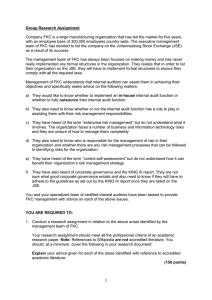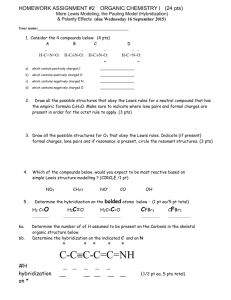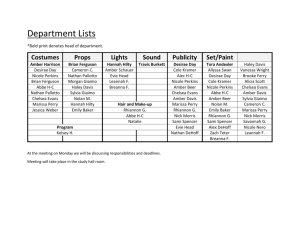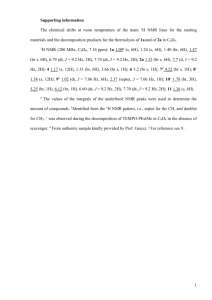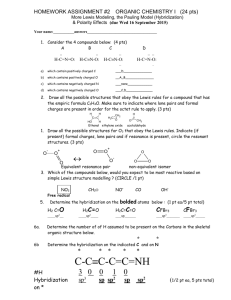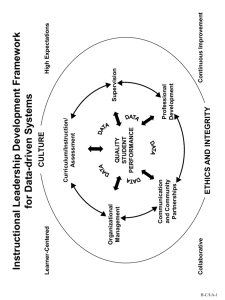Twice yearly progress reports
advertisement
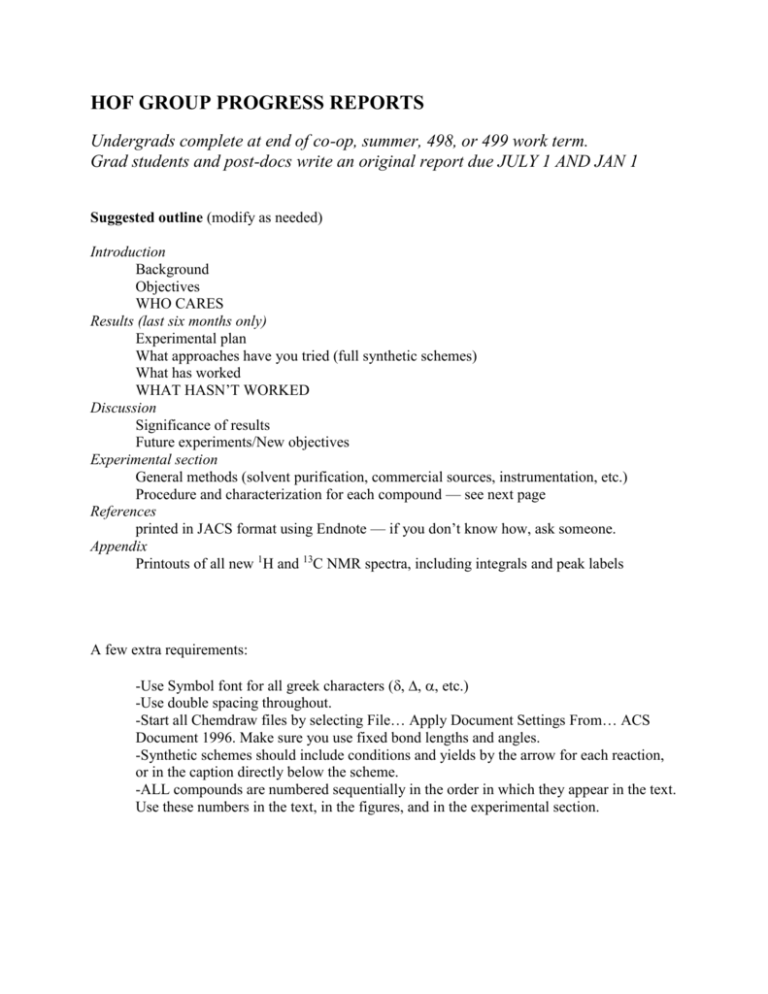
HOF GROUP PROGRESS REPORTS Undergrads complete at end of co-op, summer, 498, or 499 work term. Grad students and post-docs write an original report due JULY 1 AND JAN 1 Suggested outline (modify as needed) Introduction Background Objectives WHO CARES Results (last six months only) Experimental plan What approaches have you tried (full synthetic schemes) What has worked WHAT HASN’T WORKED Discussion Significance of results Future experiments/New objectives Experimental section General methods (solvent purification, commercial sources, instrumentation, etc.) Procedure and characterization for each compound — see next page References printed in JACS format using Endnote — if you don’t know how, ask someone. Appendix Printouts of all new 1H and 13C NMR spectra, including integrals and peak labels A few extra requirements: -Use Symbol font for all greek characters (, , , etc.) -Use double spacing throughout. -Start all Chemdraw files by selecting File… Apply Document Settings From… ACS Document 1996. Make sure you use fixed bond lengths and angles. -Synthetic schemes should include conditions and yields by the arrow for each reaction, or in the caption directly below the scheme. -ALL compounds are numbered sequentially in the order in which they appear in the text. Use these numbers in the text, in the figures, and in the experimental section. EXPERIMENTAL DATA IS REQUIRED FOR EVERY NEW COMPOUND Checklist: Mp (if solid) IR (text only) 1 H NMR (text form and printout) 13 C NMR (text form and printout) High-Res MS (text form) Notes: Write a complete experimental for every NEW compound you make to a reasonable degree of purity (~95%). Follow the example below, making sure you have all J values, multiplicities, integrations, punctuation, and italics in the format indicated. Give 1H assignments where possible. Compounds that have been fully characterized in the literature need only have a 1H NMR in text and printout form and a reference to the original preparation/characterization. NMR spectra must be transferred to the group computer and given proper peak labels and integrals AS THEY ARE COLLECTED. Your files on the group computer must be organized in such a way that they make sense to future group members. Put your printouts of NMR, MS, and IR data in a binder organized by notebook number. Printouts of 1H and 13C NMRs including peak labels and integrals must be labeled for easy identification and included as an appendix for each progress report. Sample Experimental: Compound ((±)-29c). MeO Boc N HN 4 5 6 3 1 2 7 14 12 8 10 O 2S (±) 11 13 9 A mixture of aryl bromide (±)-28 (66 mg, 0.109 mmol), Pd(OAc) 2 (1.2 mg, 0.005 mmol), 2B B (dicyclohexylphosphino)biphenyl (4.0 mg, 0.011 mmol), 2-methoxybenzeneboronic acid (30.0 mg, 0.19 mmol), and K 3 PO 4 (69.4 mg, 0.327 mmol) was placed in an oven-dried flask and B B B B flushed with argon for 20 min. Anhydrous DMF (2.0 ml) was added, and the reaction was heated at 100 °C overnight. After cooling to 22 °C, the reaction mixture was filtered through silica and concentrated to dryness on a rotary evaporator. Column chromatography (4:1 hexanes/AcOEt ) B gave the product (51.2 mg, 75%) as a white solid. Mp 45–48 °C. IR: 2929w, 2857w, 1697m, 2250w, 1697m, 1597w, 1499w, 1464m, 1422m, 1366m, 1302m, 1240m, 1162m, 1146s, 1086m, 1057w, 1027w. 1 H NMR (CDCl 3 , 300 MHz): 0.85–0.92 (m, 3 H, H-C(14) ); 1.16–1.37 (m, 6 H, P P B B B H-C(11–13) ); 1.41 (s, 9 H, Boc); 1.49–1.75 (m, 4 H, H-C(10), H-C(5) endo, H-C(6) exo); 1.83– B 1.95 (m, 1 H, H-C(5) exo); 2.44 (ddd, J = 3.2, 8.6, 11.8, 1 H, H-C(6) endo); 2.68 (t, J = 7.7, 2 H, H-C(9) ); 3.26 (dt, J = 1.6, 4.5, 1 H, H-C(2)); 3.35 (d, J = 2.6, 1 H, H-C(3)); 3.61 (d, J = 13.1, 1 B H, NCH2naph.); 3.76 (d, J = 13.1, 1 H, NCH2naph.); 3.81 (s, 3 H, OCH3); 4.29 (d, J = 5.1, 1 H, H-C(4)); 4.44 (t, J = 4.3, 1 H, H-C(1)); 6.97–7.09 (m, 3 H, ArH); 7.23 (d, J = 8.3, 2 H, H-C(8)); 7.25–7.36 (m, 4 H, ArH); 7.42 (td, J = 1.4, 7.7, 1 H, ArH); 7.72 (d, J = 8.3, 2 H, H-C(7)). 13 C P P NMR (CDCl 3 , 75 MHz): 14.2; 22.7; 24.6; 26.3; 28.4; 29.1; 31.1; 31.7; 36.0; 52.0; 55.8; 57.8; B B 61.3; 64.4; 73.9; 80.6; 111.6; 121.1; 127.0; 128.1; 128.2; 128.6; 128.8; 129.5; 129.6; 131.0; 131.1; 137.7; 139.0; 139.2; 149.8; 155.5; 156.8. HR-ESI-MS: 633.3344 (MH+, C37H49N2O5S+; calc. 633.3357).
